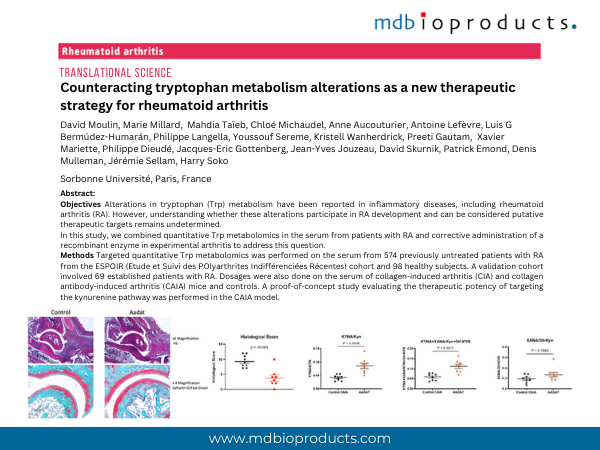
Featured Publication in Focus: Counteracting tryptophan metabolism alterations as a new therapeutic strategy for rheumatoid arthritis
Mar 12 , 2024
Authors:
David Moulin, Marie Millard, Mahdia Taïeb, Chloé Michaudel, Anne Aucouturier, Antoine Lefèvre, Luis G Bermúdez-Humarán, Philippe Langella, Youssouf Sereme, Kristell Wanherdrick, Preeti Gautam, Xavier Mariette, Philippe Dieudé, Jacques-Eric Gottenberg, Jean-Yves Jouzeau, David Skurnik, Patrick Emond, Denis Mulleman, Jérémie Sellam and Harry Soko
Sorbonne Université, Paris, France
BMJ journals. Annals of the Rheumatic Diseases. 24 November 2023
----------------------
Products referenced:
Catalogue # CIA-MAB-2C
ArthritoMab™ Antibody Cocktail for C57BL/6, TG, 50 mg
Catalogue # 804001-lyo
Collagen Type II, Bovine, Immunization Grade, Lyophilized, 10 mg
Catalogue # 501009
Complete Freund's Adjuvant, 4 mg/mL (5 mL)
----------------------
ABSTRACT
Objectives Alterations in tryptophan (Trp) metabolism have been reported in inflammatory diseases, including rheumatoid arthritis (RA). However, understanding whether these alterations participate in RA development and can be considered putative therapeutic targets remains undetermined.
In this study, we combined quantitative Trp metabolomics in the serum from patients with RA and corrective administration of a recombinant enzyme in experimental arthritis to address this question.
Methods Targeted quantitative Trp metabolomics was performed on the serum from 574 previously untreated patients with RA from the ESPOIR (Etude et Suivi des POlyarthrites Indifférenciées Récentes) cohort and 98 healthy subjects. A validation cohort involved 69 established patients with RA. Dosages were also done on the serum of collagen-induced arthritis (CIA) and collagen antibody-induced arthritis (CAIA) mice and controls. A proof-of-concept study evaluating the therapeutic potency of targeting the kynurenine pathway was performed in the CAIA model.
Results Differential analysis revealed dramatic changes in Trp metabolite levels in patients with RA compared with healthy controls. Decreased levels of kynurenic (KYNA) and xanthurenic (XANA) acids and indole derivatives, as well as an increased level of quinolinic acid (QUIN), were found in the serum of patients with RA. They correlated positively with disease severity (assessed by both circulating biomarkers and disease activity scores) and negatively with quality-of-life scores. Similar profiles of kynurenine pathway metabolites were observed in the CAIA and CIA models. From a mechanistic perspective, we demonstrated that QUIN favours human fibroblast-like synoviocyte proliferation and affected their cellular metabolism, through inducing both mitochondrial respiration and glycolysis. Finally, systemic administration of the recombinant enzyme aminoadipate aminotransferase, responsible for the generation of XANA and KYNA, was protective in the CAIA model.
Conclusions Altogether, our preclinical and clinical data indicate that alterations in the Trp metabolism play an active role in the pathogenesis of RA and could be considered as a new therapeutic avenue.
To continue reading and to download the publication:
